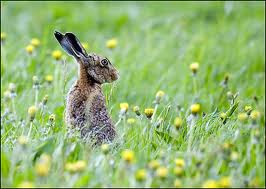Welcome to “Go Wild at Glamis.”
This is a blog for wildlife lovers.
I count myself amongst them. Since working at the castle I am constantly surprised at the amount of wildlife that is to be found here. Walking down the drive twice a day gives me an opportunity to watch the hares, the herons, the deer and of course the pheasants as they go about their daily routine. But there is more to our wildlife than immediately meets the eye.
Our Farm Director David Soutar keeps a watchful eye on the many species that live here on the estate. As part of the Volunteer and Farmer Alliance, a recent bird survey noted 22 species listed on the “cause for concern” list that make their homes here on the Estate. This is a great tribute to the conservation work here. A few of the rarer species include Yellowhammers and Tree Sparrows who both now flourish on the Estate.
But for my first entry on the blog I will write about that mystical beast, the hare.
Introduced 2,000 years ago by the Romans, the hare has a place in everyone’s heart. The species on the estate is the Brown Hare, a long legged animal with black thumbpr ints on the tips of its ears. Preferring a habitat of farmland and rough grazing, the fields surrounding the castle are very suitable for them. I have seen them, both first thing in the morning and later in the afternoon as I walk to and from a day’s guiding. The hare is a sprinter, reaching 45 mph within seconds, working on the principal of hiding and then bolting at the latest possible moment. As they don’t burrow but live in scrapes or “forms,” hares blend well into the landscape, seemingly appearing from nowhere to dash across your path.
ints on the tips of its ears. Preferring a habitat of farmland and rough grazing, the fields surrounding the castle are very suitable for them. I have seen them, both first thing in the morning and later in the afternoon as I walk to and from a day’s guiding. The hare is a sprinter, reaching 45 mph within seconds, working on the principal of hiding and then bolting at the latest possible moment. As they don’t burrow but live in scrapes or “forms,” hares blend well into the landscape, seemingly appearing from nowhere to dash across your path.
The mythology of the hare encompasses the entire globe with the symbol of three hares chasing each other in an endless circle appearing in Christian, Jewish, Buddhist and Islamic sites as far back as 600 BC. In the British Isles, the hare was believed to be the favourite of the Celtic goddess Eostre associated with love, fertility and growth. It was the pagan goddess Eostre who became linked with Christian beliefs to become Easter and it was originally the hare and not the Easter bunny who carried eggs on its back as a symbol of rebirth and spring. As the date of Easter is linked with the cycle of the moon, hares also have strong lunar associations.
We have all heard the expression “mad as a March hare.” This appertains to the curious boxing matches that occur in the spring during the breeding season. Having seen this myself, I can understand this particular phrase, the leaping and boxing between animals is really bizarre to watch.
All in all, this resident of the castle grounds is one of the most intriguing to be seen. I count myself lucky to have the opportunity to share my walk to work with this most magical beast.
